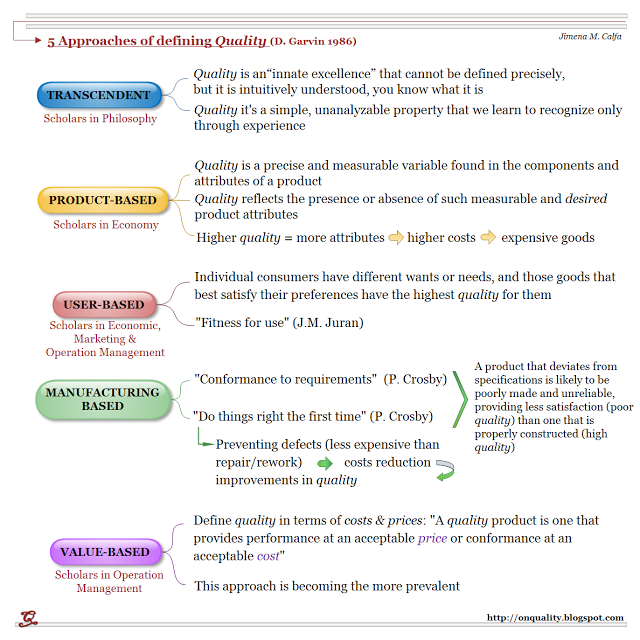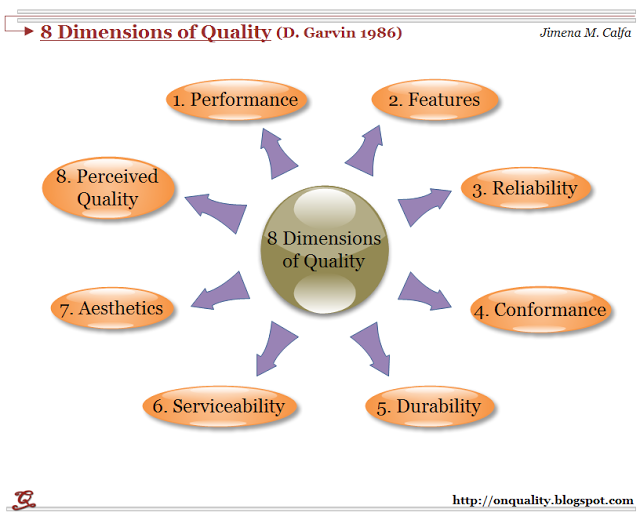Dr. David A Garvin, Ph.D professor of Business Administration Harvard Business School wrote an interesting article about “What does product quality really mean?” where:
- He identified 5 major approaches of defining quality arising from scholars in 4 disciplines: philosophy, economics, marketing, and operations management.
- He built an 8-dimensional framework to elaborate on those definitions.
- Using that framework, he addresses the empirical relationships between quality and some important variables.
5 APPROACHES
The following mind map, explain the 5 approaches of defining quality:
8 DIMENSIONS
Dr. Garvin identified 8 dimensions as a framework for thinking about the basic elements of product quality. Each dimension is self-contained and distinct; a product can be ranked high on one dimension while being low on another.
Together, the 8 dimensions of quality cover a broad range of concepts. Several of the dimensions involves measurable product attributes, others reflect individual preferences. Some are objective and timeless, while others shift with changing fashions. Some are inherent characteristics of goods, while others are ascribed characteristics.
The following graph shows the 8 dimensions; they are put in order from basic/essential to additional but not les important characteristics:
It refers to product’s primary operating characteristics; in other words it refers to the efficiency with a product achieves its intended purpose. i.e.: acceleration in an automobile.
2. Features
They are the “bells and whistles” of products, the extras that supplement the Performance characteristics. i.e.: free drinks in a plane flight.
3. Reliability
It reflects the probability of a product’s failing within a specified period of time; in other words it reflects the propensity of a product to perform consistently over its useful designed life.
Common measures of reliability in durable goods: MTFF (mean time to first failure) and MTBF (mean time between failures). (*)
4. Conformance
It refers to the degree to which a product’s design and operating characteristics match preestablished standards.
It involves:
* Internal elements (within the factory): conformance is measured commonly by the incidence of defects (proportion of all units that fail to meet specifications and so required rework or repair).
* External elements (in the filed): conformance is measured commonly by the quantity of repairs under warranty.
5. Durability
It refers to the measure of product life, defined in 2 dimensions:
* Technically: durability is the amount of use one gets from a product before it physically deteriorates, and the repair is impossible (i.e. after so many hours of use, the filament of a light bulb burns up and the bulb must be replaced).
* Economically: durability is the amount of use one gets from a product before it breaks down, and the repair is possible.
The product’s life is determined by repair costs, personal valuations of time and inconveniences, losses due to downtime and other economic variables. (*)
6. Serviceability
It refers to the speed, courtesy, and competence of the repair service. Objective and subjective views play a role in defining serviceability.
7. Aesthetics
How a product looks, feels, sounds, tastes, or smells (appearance and impression): quality is view as the combination of these attributes that best match the consumer preferences.
8. Perceived Quality
The manner and feel the consumers’ experiment using the product.
(*) Durability and Reliability are related: a product that fails frequently (low Durability), is likely to be scrapped earlier than one that is more Reliable.
The diversity of these concepts helps to explain the differences among the 5 traditional approaches to quality, previously explained. Each of the approaches focuses implicitly on a different dimension of quality:
- The Product-based Approach focuses on performance, features, and durability
- The User-based Approach focuses on aesthetics and perceived quality
- The Manufacturing-based Approach focuses on conformance and reliability: improvements in both measures are normally viewed as translating directly into quality gains (objective measures of quality). They are less likely to reflect individual preferences.







2 Comments
Dwarika · November 26, 2012 at 5:49 am
Salute to you for bringing such a nice article on quality and it has cleared my basic understanding quality of an product.
mondli mfayela · September 28, 2015 at 11:48 pm
This comment has been removed by the author.
Comments are closed.